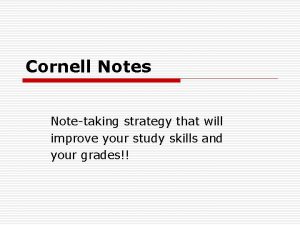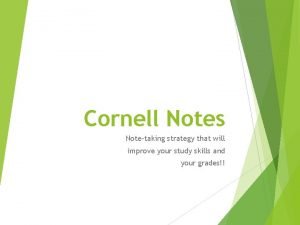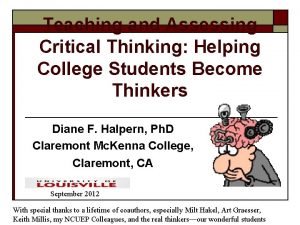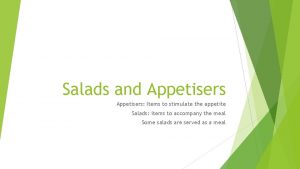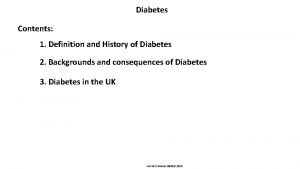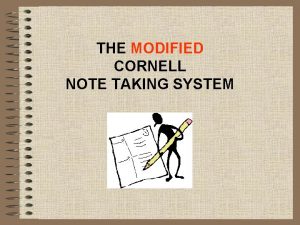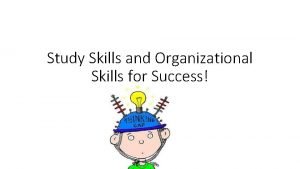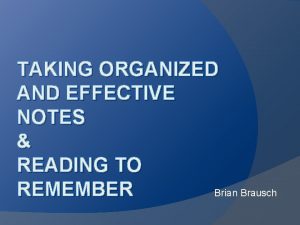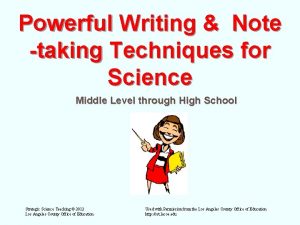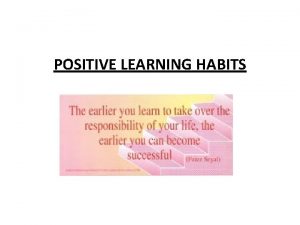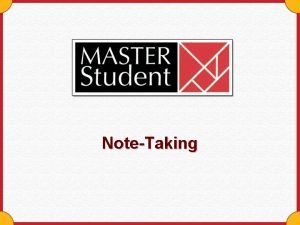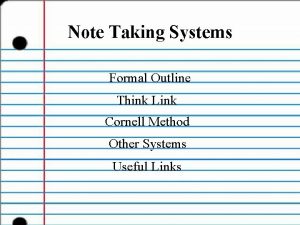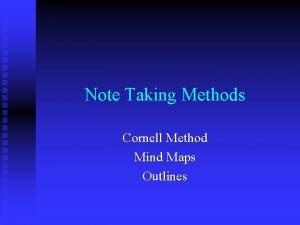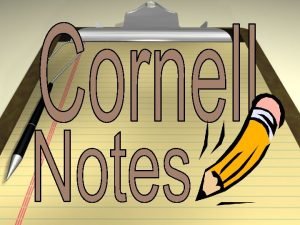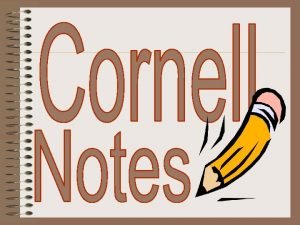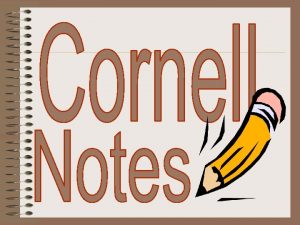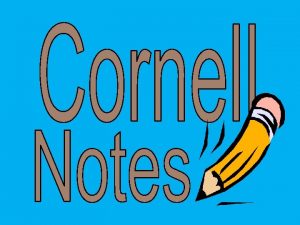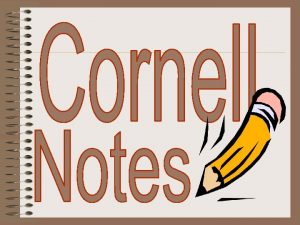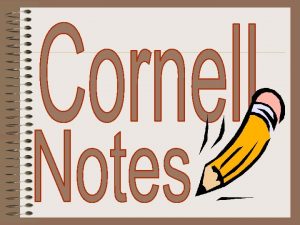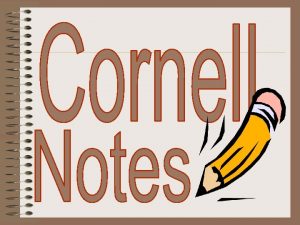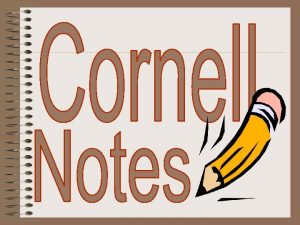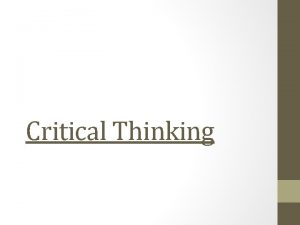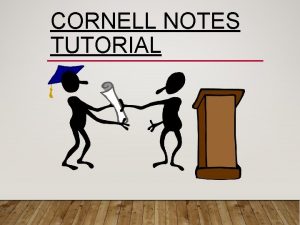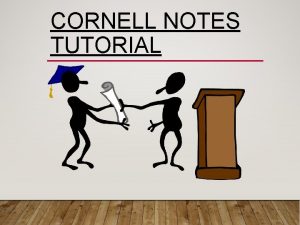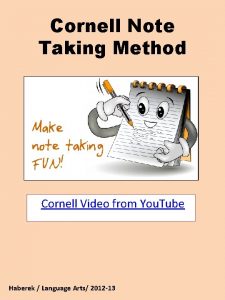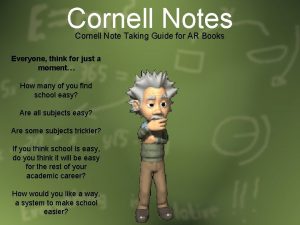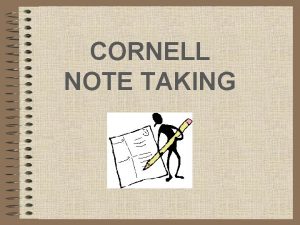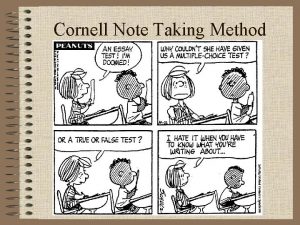Cornell note taking stimulates critical thinking skills Note

























- Slides: 25


• Cornell note taking stimulates critical thinking skills. • Note taking helps students remember what is said in class. • A good set of notes can help students work on assignments and prepare for tests outside of the classroom.

• Good notes allow students to help each other problem solve. • Good Notes help students organize and process data and information. • Helps student recall by getting them to process their notes 3 times. • Writing is a great tool for learning!

• Developed in 1949 at Cornell University by Walter Pauk. • Designed in response to frustration over student test scores. • Meant to be easily used as a test study guide. • Adopted by most major law schools as the preferred note taking method.

The Set Up 2 1/2” or 1/3 of the page Fold the bottom of the page up about ¼ of the paper.

First & Last Name Class Title Period Date Questions, Subtitles, Headings, etc. Students form their own questions from the info on the Notes using higher level thinking (Bloom’s or Costa’s). What Goes Where? Topic or Title Class Notes can be taken in any format: outline, bullet, concept map, etc. Summary: across the bottom of the last page or the first page of the day’s notes

Date: 11/20/01 PROCESS (output) Title: Why take Cornell notes? Main Ideas (input) Can be used to provide an outline of chapter or lecture. Organized by main ideas and details. How can Cornell notes Can be as detailed as necessary. Sequential-- take notes as they are given by instructor or help me text in an orderly fashion. organize my After class, write a summary of what you learned to ideas? clarify and reinforce learning and to assist retention. Can be used as study tool: Which side for 1. Define terms or explain concepts listed on left side. diagrams? 2. Identify the concept or term on the right side. Can be used to provide a "big picture" of the chapter or Why use concept maps? lecture. Organized by main ideas and sub-topics Limited in how much detail you can represent. Simultaneous- you can use this method for instructors who jump around from topic to topic. After class, you can add questions to the left side What are the Can be used as a study tool -- to get a quick overview benefits to me? and to determine whether you need more information or need to concentrate your study on specific topics.

• Summary is added at the end of ALL note pages on the subject (not each page). • Summary is added AFTER questions are finished. • Summary is a summary of the information in the notes, usually about 4 sentences but depends on the amount of info in the notes.



Warm Up • Give students the following situation: Yesterday afternoon, there was a fight that broke out in the gymnasium directly after the student-teacher basketball game. You are a security officer called in to respond to the fight. Your job is to find out what happened. How would you verify the facts surrounding this fight? (Vantage point) • LEFT Side

(Questions about it ) • How do the ticks find the cattle? • Why don’t the ticks usually kill their host? • How could tick infestations in cattle impact humans? (Diagram copied during lecture)

• In the large, right hand column, take notes like you normally would. • You may use any style of notetaking you wish: – – outline format, narrative format, symbols, short hand, etc. – ex. Texting

• With your partner(s), create questions in the left hand column. • These questions should elicit critical thinking skills. – Levels 3 through 6 in Bloom’s Taxonomy.

1. KNOWLEDGE: recalling information 2. COMPREHENSION: understanding meaning 3. APPLICATION: using learning in new situations 4. ANALYSIS: ability to see parts & relationships 5. SYNTHESIS: Use parts to create a new whole 6. EVALUATION: judgment based on criteria

Category Example and Key Words Examples: Recite a policy. Quote prices from memory to a customer. Knows the safety rules. 1. Knowledge: Recall data or information. Key Words: defines, describes, identifies, knows, labels, lists, matches, names, outlines, recalls, recognizes, reproduces, selects, states. 2. Comprehension: Understand the meaning, translation, interpolation, and interpretation of instructions and problems. State a problem in one's own words. Examples: Rewrites the principles of test writing. Explain in one's own words the steps for performing a complex task. Translates an equation into a computer spreadsheet. Key Words: comprehends, converts, defends, distinguishes, estimates, explains, extends, generalizes, gives Examples, infers, interprets, paraphrases, predicts, rewrites, summarizes, translates. Examples: Use a manual to calculate an 3. Application: Use a concept in a new employee's vacation time. Apply laws of statistics situation or unprompted use of an to evaluate the reliability of a written test. abstraction. Applies what was learned in Key Words: applies, changes, computes, the classroom into novel situations in the constructs, demonstrates, discovers, manipulates, modifies, operates, predicts, prepares, produces, work place. relates, shows, solves, uses.

Examples: Troubleshoot a piece of equipment by using logical deduction. Recognize logical fallacies in reasoning. Gathers information from 4. Analysis: Separates material or concepts into component parts so that a department and selects the required tasks for training. its organizational structure may be Key Words: analyzes, breaks down, compares, understood. Distinguishes between contrasts, diagrams, deconstructs, differentiates, facts and inferences. discriminates, distinguishes, identifies, illustrates, infers, outlines, relates, selects, separates. Examples: Write a company operations or process manual. Design a machine to perform a specific task. Integrates training from several 5. Synthesis: Builds a structure or sources to solve a problem. Revises and pattern from diverse elements. Put process to improve the outcome. parts together to form a whole, with Key Words: categorizes, combines, compiles, emphasis on creating a new meaning composes, creates, devises, designs, explains, or structure. generates, modifies, organizes, plans, rearranges, reconstructs, relates, reorganizes, revises, rewrites, summarizes, tells, writes. Examples: Select the most effective solution. Hire the most qualified candidate. Explain and justify a new budget. 6. Evaluation: Make judgments about Key Words: appraises, compares, concludes, contrasts, criticizes, critiques, defends, the value of ideas or materials. describes, discriminates, evaluates, explains, interprets, justifies, relates, summarizes,

Your questions should reflect: • Info you don’t understand or want to discuss with your teacher/tutor. • Info you think would go good on an essay test. • Gaps in your notes.

• On your own, in the space provided at the bottom of the page, complete a summary of what you wrote in your notes.

Anthropods



• May reflect headings in Power. Point lectures • Leave room on the left for questions and diagrams • Leave plenty of room within the outline for student note-taking

Congratulations! You have just learned how to take Cornell Notes which have been proven to be a successful strategy for learning. The reasons for this success include: • Writing of the Information • Review of the Important Terms • Restructuring Information into a New Format • Summarizing Into Your Own Words This process should help you learn and understand the content!

Take out a sheet of paper and get ready to practice.
 Cornell note taking method
Cornell note taking method Cornell note taking strategy
Cornell note taking strategy Cornell note taking strategy
Cornell note taking strategy Difference between note making and note taking
Difference between note making and note taking Word signal
Word signal Difference between note making and note taking
Difference between note making and note taking Note making advantages
Note making advantages Critical semi critical and non critical instruments
Critical semi critical and non critical instruments Principle of sterilization
Principle of sterilization Note taking skills
Note taking skills Perbedaan critical thinking dan creative thinking
Perbedaan critical thinking dan creative thinking Thinking skills
Thinking skills A type of salad that stimulates the appetite
A type of salad that stimulates the appetite Insulin stimulates
Insulin stimulates Chapter 9 cellular respiration harvesting chemical energy
Chapter 9 cellular respiration harvesting chemical energy Modified cornell
Modified cornell Cornell note setup
Cornell note setup Cornell skills for success
Cornell skills for success Sentence method of note taking
Sentence method of note taking Section 17-3 note taking guide answer key
Section 17-3 note taking guide answer key What are the five r's of note taking
What are the five r's of note taking What are the 5 r's of note taking
What are the 5 r's of note taking Note taking process
Note taking process Outline method of note taking
Outline method of note taking Prerequisites of note-taking
Prerequisites of note-taking Mind mapping note taking method
Mind mapping note taking method

